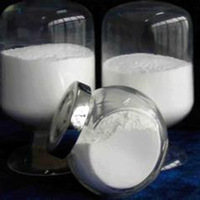描述
Product Description: Boric Acid
Product Alias: Boracic Acid, Orthoboric Acid
Appearance: White crystalline powder
Character: Boric acid is a weak, monobasic Lewis acid with antiseptic, antifungal, and antiviral properties. It is odorless and has a slightly sweet taste. It is soluble in water and glycerol but insoluble in most organic solvents.
Category: Pharmaceutical Chemical
Chemical Formula: H3BO3
Molecular Formula: B(OH)3
Introduction: Boric acid, also known as boracic acid, is a versatile compound widely used in various industries, including the pharmaceutical industry. It is derived from boron, a naturally occurring element found in rocks, soil, water, and plants. Boric acid has been recognized for its medicinal properties for centuries and continues to be an essential ingredient in pharmaceutical applications.
Applications in the Pharmaceutical Industry:
-
Antiseptic and Antifungal Agent: Boric acid is commonly used as an antiseptic and antifungal agent in pharmaceutical formulations. It exhibits broad-spectrum activity against various microorganisms, including bacteria, fungi, and viruses. It is often used in topical ointments, creams, and lotions to treat skin infections, wounds, and burns. Its antifungal properties make it effective in treating conditions like athlete’s foot, ringworm, and yeast infections.
-
Eye and Ear Care: Boric acid is used in the pharmaceutical industry to formulate eye and ear care products. It is commonly found in eye drops, eyewashes, and contact lens solutions. Due to its mild antiseptic properties, boric acid helps cleanse and soothe the eyes and ears, providing relief from irritation, redness, and dryness. It is also used in the preparation of ear drops to treat ear infections and remove excess earwax.
-
Buffering Agent: Boric acid acts as a buffering agent in various pharmaceutical formulations. It helps maintain the pH balance of solutions, ensuring stability and efficacy of medications. By regulating the acidity or alkalinity of a formulation, boric acid enhances the effectiveness of active ingredients and prolongs the shelf life of pharmaceutical products.
-
Preservative: Boric acid is used as a preservative in pharmaceutical preparations, particularly in ophthalmic solutions and oral medications. It helps prevent the growth of bacteria and fungi, thereby extending the shelf life of these products. Boric acid’s preservative properties make it a valuable ingredient in multi-dose eye drops, nasal sprays, and oral suspensions.
-
Excipient: Boric acid serves as an excipient in pharmaceutical formulations, acting as a stabilizer, emulsifier, or viscosity modifier. It enhances the physical and chemical properties of medications, ensuring uniformity, consistency, and ease of administration. Boric acid is often used in the production of tablets, capsules, and suppositories.
Safety Precautions: While boric acid is generally considered safe for pharmaceutical use, it is important to follow proper handling and storage guidelines. It should be kept away from children and pets, as ingestion or prolonged exposure can be harmful. In rare cases, excessive use or sensitivity to boric acid may cause skin irritation or allergic reactions. It is advisable to consult a healthcare professional before using any pharmaceutical product containing boric acid.
Conclusion: Boric acid is a valuable compound in the pharmaceutical industry, offering a range of applications due to its antiseptic, antifungal, buffering, and preservative properties. Its versatility and effectiveness make it a preferred ingredient in various pharmaceutical formulations, ensuring the safety and well-being of patients. When used responsibly and in accordance with recommended guidelines, boric acid plays a crucial role in promoting health and providing effective treatment options.
